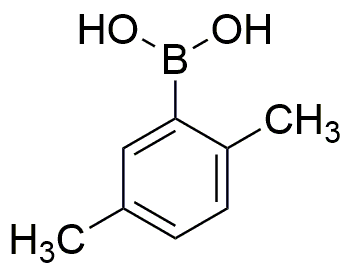2,5-Dimethylphenylboronic acid is widely utilized in research focused on:
- Organic Synthesis: This compound serves as a key intermediate in the synthesis of various organic molecules, particularly in the development of pharmaceuticals and agrochemicals, enhancing the efficiency of chemical reactions.
- Cross-Coupling Reactions: It plays a crucial role in Suzuki-Miyaura coupling reactions, which are essential for forming carbon-carbon bonds in complex organic compounds, making it valuable in the production of fine chemicals.
- Sensor Development: The compound is used in the fabrication of sensors for detecting biomolecules, offering high sensitivity and selectivity, which is beneficial in medical diagnostics and environmental monitoring.
- Material Science: It contributes to the development of advanced materials, including polymers and nanomaterials, which are used in electronics and coatings, providing improved performance and durability.
- Biological Applications: This boronic acid derivative is explored for its potential in drug delivery systems and as a therapeutic agent, particularly in targeting specific biological pathways, thus presenting a promising avenue in medicinal chemistry.
General Information
Properties
Safety and Regulations
Applications
2,5-Dimethylphenylboronic acid is widely utilized in research focused on:
- Organic Synthesis: This compound serves as a key intermediate in the synthesis of various organic molecules, particularly in the development of pharmaceuticals and agrochemicals, enhancing the efficiency of chemical reactions.
- Cross-Coupling Reactions: It plays a crucial role in Suzuki-Miyaura coupling reactions, which are essential for forming carbon-carbon bonds in complex organic compounds, making it valuable in the production of fine chemicals.
- Sensor Development: The compound is used in the fabrication of sensors for detecting biomolecules, offering high sensitivity and selectivity, which is beneficial in medical diagnostics and environmental monitoring.
- Material Science: It contributes to the development of advanced materials, including polymers and nanomaterials, which are used in electronics and coatings, providing improved performance and durability.
- Biological Applications: This boronic acid derivative is explored for its potential in drug delivery systems and as a therapeutic agent, particularly in targeting specific biological pathways, thus presenting a promising avenue in medicinal chemistry.
Documents
Safety Data Sheets (SDS)
The SDS provides comprehensive safety information on handling, storage, and disposal of the product.
Product Specification (PS)
The PS provides a comprehensive breakdown of the product’s properties, including chemical composition, physical state, purity, and storage requirements. It also details acceptable quality ranges and the product's intended applications.
Certificates of Analysis (COA)
Search for Certificates of Analysis (COA) by entering the products Lot Number. Lot and Batch Numbers can be found on a product’s label following the words ‘Lot’ or ‘Batch’.
*Catalog Number
*Lot Number
Certificates Of Origin (COO)
This COO confirms the country where the product was manufactured, and also details the materials and components used in it and whether it is derived from natural, synthetic, or other specific sources. This certificate may be required for customs, trade, and regulatory compliance.
*Catalog Number
*Lot Number
Safety Data Sheets (SDS)
The SDS provides comprehensive safety information on handling, storage, and disposal of the product.
DownloadProduct Specification (PS)
The PS provides a comprehensive breakdown of the product’s properties, including chemical composition, physical state, purity, and storage requirements. It also details acceptable quality ranges and the product's intended applications.
DownloadCertificates of Analysis (COA)
Search for Certificates of Analysis (COA) by entering the products Lot Number. Lot and Batch Numbers can be found on a product’s label following the words ‘Lot’ or ‘Batch’.
*Catalog Number
*Lot Number
Certificates Of Origin (COO)
This COO confirms the country where the product was manufactured, and also details the materials and components used in it and whether it is derived from natural, synthetic, or other specific sources. This certificate may be required for customs, trade, and regulatory compliance.


